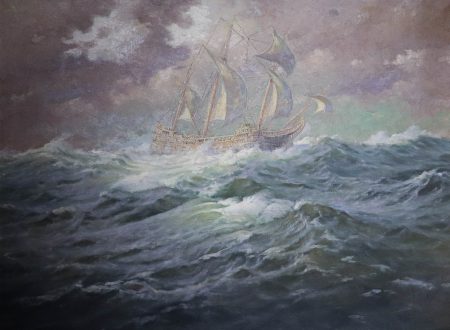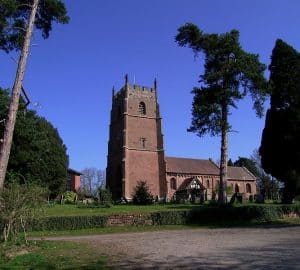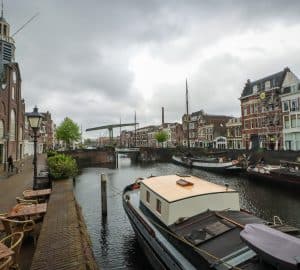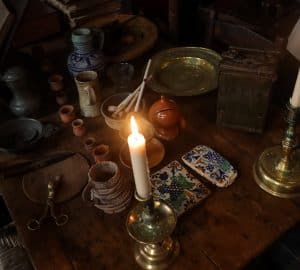
The smoke curled upward from an open-air fire as the smell of roasting turkey filled the air. Near the roasting turkey was another large fire, over which was hung a large iron pot. In the pot were several large lobsters as well as some mussels and oysters. Standing over the fire and tending to the cooking was an aging lady of fifty-two years. She was the oldest lady in the colony, loved and respected by all. As the colony at Plymouth Harbor prepared for a three-day festival of thanksgiving to God for His abundant goodness, it was only natural that most of the work of preparation would fall upon her shoulders.
But as Mary Brewster prepared the food for the harvest festival, she could not help looking back at all the steps that had brought her to this point. At her side were only three other adult women in the colony. All the others had perished in the plague of the previous winter. There were plenty of mouths to feed, but fully half of the 100 passengers that had journeyed across the ocean on the Mayflower now lay in a shallow grave on the top of the hill.
As a little girl growing up in Nottinghamshire, Mary would never have guessed that, fifty years later, on the other side of the ocean, she would be spending her elderly years cooking over an open fire, planting and harvesting corn, gathering berries in the thickets of the New World, plucking geese and ducks, cleaning fish, tending the dying, burying the dead, sleeping in a bare house, and washing her clothes by hand in a small brook near the village.
We know very little about the family origins of Mary Brewster. Even her maiden name, in spite of the most diligent searches, remains hidden in the mist of history. We know that she was born in 1569, and that she was married to William Brewster around 1592 at the age of 23. The marriage was never officially recorded in the parish church, presumably because William Brewster was already skeptical of the outward show of the state church.

William and Mary Brewster lived comfortably in a large manor house in the village of Scrooby. The Brewster family had deep roots in the area, and William filled his father’s position as postmaster in the town. Scrooby Manor was a large and stately house that had ample room for weekly gatherings of like-minded believers. The Brewsters invited John Robinson and Richard Clifton to hold weekly services in their home. They also opened their home as a resting place for a young orphaned lad named William Bradford.
The Lord blessed Mary Brewster with three surviving children while still living in England. The eldest son, Jonathan, was born in August of 1593. A girl named Patience was born in 1600. The third child, also a daughter, was born in 1606, and was named Fear. The name of this third child indicates the growing uncertainty of life in England for Mary Brewster.
In spite of the fact that they were comfortable in their home in Scrooby, increasing pressure from the Church of England had made it clear to the leaders of the congregation that they could no longer safely stay in England. Mary Brewster was forced to leave behind the comfortable life that she had known and follow her husband into a new life in the Low Countries. After several failed attempts to leave, including a painful separation from her husband when William was arrested along with other leaders at Scotia Creek, the Brewsters were able to make it safely to the Low Countries.
After a year in Amsterdam, the congregation moved to Leiden. William and Mary Brewster took up residence in a small home where they struggled to make a living. William provided for his growing family by teaching English to Dutch University students.
In Leiden, Mary Brewster gave birth to at least three more children. An unnamed child was born in 1609, but died shortly after. A son named Love was born in 1611. Another son was born in 1614, and was named Wrestling. This brought the number of living children to five. By this time, the eldest son, Jonathan, was able to obtain work as a ribbonmaker, and his earnings helped to maintain the family income.
In 1616, the Brewsters began a clandestine printing operation, printing and publishing a series of pamphlets that spoke against the errors of the Church of England. King James was outraged by the circulation of the booklets, and ordered an international manhunt for the printer. William Brewster took an assumed name for a while, and went into hiding to protect his wife and children.
In 1620, when the decision was finally made to leave Leiden and set sail for the New World, most of the elderly members of the congregation, including the pastor, John Robinson, decided to stay behind. But William and Mary Brewster took their places among the young people setting out for life in the wilderness of North America.
The Brewsters took their two youngest children, Love and Wrestling, with them aboard the Mayflower. It was their hope that the older children would eventually join them in the New World. It was a painful parting from Jonathan, Patience, and Fear, but Mary Brewster found comfort in the hope that her children would join her again, in heaven if not upon this earth.

Mary Brewster was unused to the wild storms of the North Atlantic. As the oldest woman on board the ship, she bore her share of the difficulties. As an experienced mother, she would have assisted Elizabeth Hopkins, one of the “Strangers” on the Mayflower, when she gave birth to her son at sea. The infant boy was given the name Oceanus. Mrs. Brewster also would have aided Susannah White, one of the Separatist mothers, after the arrival of the ship at Cape Cod, as she gave birth to a healthy boy named Peregrine. For many agonizing weeks, the women and children remained in the cramped and filthy quarters on the Mayflower, as the men explored the coast of Cape Cod looking for a suitable place for a settlement.
During that first awful winter, Mary Brewster was one of only five surviving adult women. In spite of her relatively advanced age, she endured the sickness, the cold, the hunger, and the hardships with fortitude. She was a constant nurse to the sick and dying, and was one of those mentioned by a grateful Bradford as one of those who “did all the homely and necessary offices which dainty and queasy stomachs cannot endure . . . and all this willingly and cheerfully.”
With the arrival of spring, Mary Brewster took her place planting corn and vegetables. Familiar with the comforts of a stately home in England, she courageously met the challenges of life in the wilderness. After another adult woman died during that summer, Mary Brewster was one of only four adult women who were left alive to prepare the food for the “First Thanksgiving” of 1621.
As Elder Brewster took leadership among the men and became the spiritual shepherd of the flock, so also Mary Brewster became the lady who encouraged and inspired the younger women with her own example of selfless service.
Mary’s two daughters joined their parents in Plymouth, and Mrs. Brewster had the joy of welcoming many grandchildren into the world before her own death in 1627. Her descendants number in the tens of thousands today and include such notable names as President Zachary Taylor, Commodore Oliver Hazard Perry, General George B. McClellan, and hymn-writer Fanny Crosby.
Bibliography
Of Plymouth Plantation by William Bradford
Mourt’s Relation
Chief of the Pilgrims by Ashbel Steele





Lovely article. Most informative. Thank you.